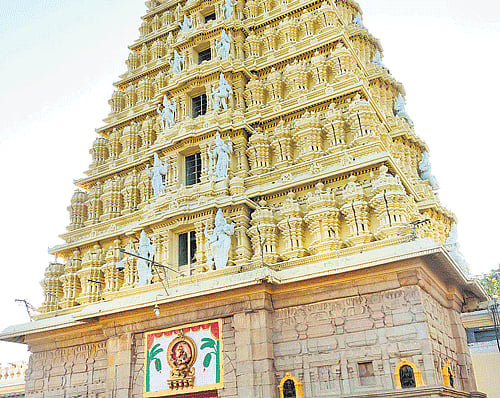
I am atop the Chamundi Hills, looking down at the panoramic view of the city of Mysore. No matter how many times one has visited the place the charm and tranquility of the hills never seem to fade.
It has an enchanting surrounding comprising green forests, a variety of birds and wild flowers that seem to light up the place.
I recall the history that is intricately woven with legends and mythology. The Skanda Purana mentions a sacred place called Trimuta Kshetra surrounded by eight hills.
Lying on the western side is the Chamundi Hills, one among these eight. It is believed to be one of the most sacred hills of South India. Located about three kilometres east of Mysore, it is the prime landmark of the city, visible from a distance. There is a 12-kilometre road leading to the top of the hill that is 3,489 ft high.
There is also a long stone stairway with 1,008 steps leading to the top of the hill. The steps pass the large statue of Nandi, Lord Shiva’s bull, that is 16 feet high and 25 feet long. Dodda Devaraja Wodeyar is said to have installed this statue and also got these steps built in 1664 AD.
The name Mysore is derived from mahishur or Mahishasurana Ooru, which means “the town of Mahishasura” in Kannada.
According to the Devi Purana, the place was once ruled by Mahishasura, a buffalo-headed demon who terrorised the entire population, including the gods. In response to the prayers of the people Devi Parvathi took the form of Chamundeshwari in order to vanquish Mahishasura. All the gods came to her assistance.
Lord Shiva gave her a trident, Lord Vishnu gave her a disc, Varuna gave her a conch-shell and a noose and Agni gave her a spear. Vayu gave her a quiver full of arrows, Indra gave her a thunderbolt and his elephant Airavata gave her a bell. Yama gave her a sword and shield and Vishwakarma gave her an axe and an armour. Himavat, the god of mountains, gave her jewels to wear and a lion to ride on.
Armed with all these, Devi Chamundeshwari confronted Mahishasura and struck down his entire army effortlessly. A fierce battle raged where she fought Mahishasura for nine days (navaratra) and killed him. She then came to be known as Mahishasuramardini – the killer of Mahishasura. Gods watching the battle from the heavens showered flowers on her from above. Chamundi or Chamundeshwari is the fierce form of Devi. She is the slayer of demons, like Chanda, Munda as well as Mahishasura. So the hill came to be named after her.
Prior to this, legends say, the hill was known by the name Mahabalachala, by the name of the deity Mahabaleshwara who resided atop the hill. Indeed, this ancient temple is the oldest one here. An inscription found on the Chamundi Hills, belongs to 950 AD when the Gangas ruled this kingdom. It is the oldest inscription found in Mysore. The Cholas ruled Mysore for more than a century after the Gangas, followed by the Chalukyas and the Cholas. Then the Hoysalas took over during the 12th Century. After the Hoysalas came the Vijayanagar Kings and the Mysore Yadu dynasty came to power in 1399 AD. They were the feudatories of the Vijayanagar Kings.
The main attraction of the Chamundi hills is the beautiful temple dedicated to Chamundeshwari, built in the 12th Century by King Vishnuvardhana of the Hoysalas. It was further renovated by the Vijayanagar and Wodeyar kings later. The beautiful gopura (tower) was built during the time of Krishnaraja Wodeyar III in 1827 AD.
Chamundeshwari is the family deity of the Maharajas so Dasara is celebrated here with great jubilation. To this day, the Wodeyars pay tribute to the goddess with a special puja at this temple before flagging-off the festivities. There is also an imposing statue of Mahishasura with a sword in his right hand and a cobra in the left. Pilgrims and tourists flock here to worship at the shrine and admire the beauty of the place. The roads are good and there is a regular bus service and also taxis to visit the Chamundi Hills.
